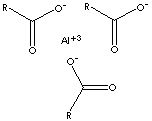ALUMINUM STEARATE
PRODUCT IDENTIFICATION
300-92-5, 36816-06-5 (Distearate)

206-101-8 ((Distearate)
TOXICITY
SMILES
CLASSIFICATION
EXTRA NOTES
PHYSICAL AND CHEMICAL PROPERTIES
white powder
145 C (Distearate), 118 C (Tristearate)
Insoluble
Insoluble in alcohol, ether; soluble in alkali, BTX, glycol, chlorinated hydrocarbons, mineral and vegetable oils
REFRACTIVE INDEX
EXTERNAL LINKS & GENERAL DESCRIPTION
http://www.doiserbia.nb.rs/
Aluminum
soaps have different and widespread applications (1-4), aluminum
stearates being among them especially important. Aluminum tristearate
is useful in paints and enamels and in the flatting of varnishes.
It also prevents bleeding and oil separation in putty. Aluminum
distearate is the most commonly used grade of aluminum stearate.
It is used as a thickener in paints, inks and greases; a water repellent
for leather and rope; and a lubricant in plastics and rope. It is
also used in cement production for waterproofing and air entrainment,
and in hot-melt paper coating compounds. Because of its unusually
heavy bodying properties, aluminum monostearate is used in the manufacture
of paints, inks, greases, and waxes (3). In recent years (5), hydrophobic
aluminum monostearate was tested as a low-solubility denitrification
substrate for anaerobic bacteria and a source of aluminum for phosphate
precipitation. Aluminum stearate has potential for use in a flow-through
container for denitrification of oxidized effluent from home sewage
systems. It was also referred that the preheated mixture of metal
soaps, along with the costabilizer, delayed the fast blackening
of the polymer, but mainly showed a reduction
Local:
GENERAL
DESCRIPTION OF METALLIC SALTS OF FATTY ACIDS:
Metallic salts of fatty acids (called soap) are primarily used as cleansing
agent (mainly sodium- and potassium-) which their molecules attach readily to
both polar molecules (of water) and non-polar molecules (of grease or oil). The
long hydrocarbon chains are non-polar (and hydrophobic) repelled by water and
the salt end molecules are ionic (and hydrophilic) water soluble. Soaps differ
according to the type of fatty acid and length of the carbon chain and according
to the alkali employed. Fatty acids with longer chains are insoluble. If sodium
hydroxide is used as the alkali, hard soaps are formed; potassium hydroxide
yields soft soaps. Soap salts are used as insecticides, herbicides, fungicides
and algaecides. The lipophilic carbon chains infiltrate
and destroy the lipoprotein matrix of the insect's cell
membranes. Food grade soap salts are used also as general
purpose food additives. Aluminum, calcium, magnesium, lead, zinc or other metals are
used in place of sodium or potassium for soaps to be used in industry. Metallic
salts of fatty acids are used as stabilizer and plasticizer in plastic industry
as well as in cosmetics. They are used as flatting and sanding agents in
lacquers, coatings & inks. They can be applied in tablet manufacturing. They
are used as drying lubricants and dusting agents for rubbers. They are used as
catalysts in chemical synthesis and emulsifiers for emulsion polymerization of
synthetic rubber and resin which can be approved for use in food contact
applications. They are used as waterproofing additives and ointments.
APPLICATIONS:
Aluminium
Stearate is used as a lubricant in the production of
polyamides and thermosetting plastics. It is used as
a thickening agent in the production of varnishes and
lacquers. It is also used as a water repellent agent
and hydrophobic agent.
DISTEARATE
APPEARANCE
White Powder
Al2O3 CONTENT
12.0 ± 1.5��
MELTING POINT
150 - 170 C
8.0% min
1.0% max ( 200 mesh)
3.0% max
TRISTEARATE
APPEARANCE
White Powder
Al2O3 CONTENT
10.0 ± 1.0��
MELTING POINT
150 C min
3.0% max
4.0% max
1.0% max ( 200 mesh)
PRICE INFORMATION